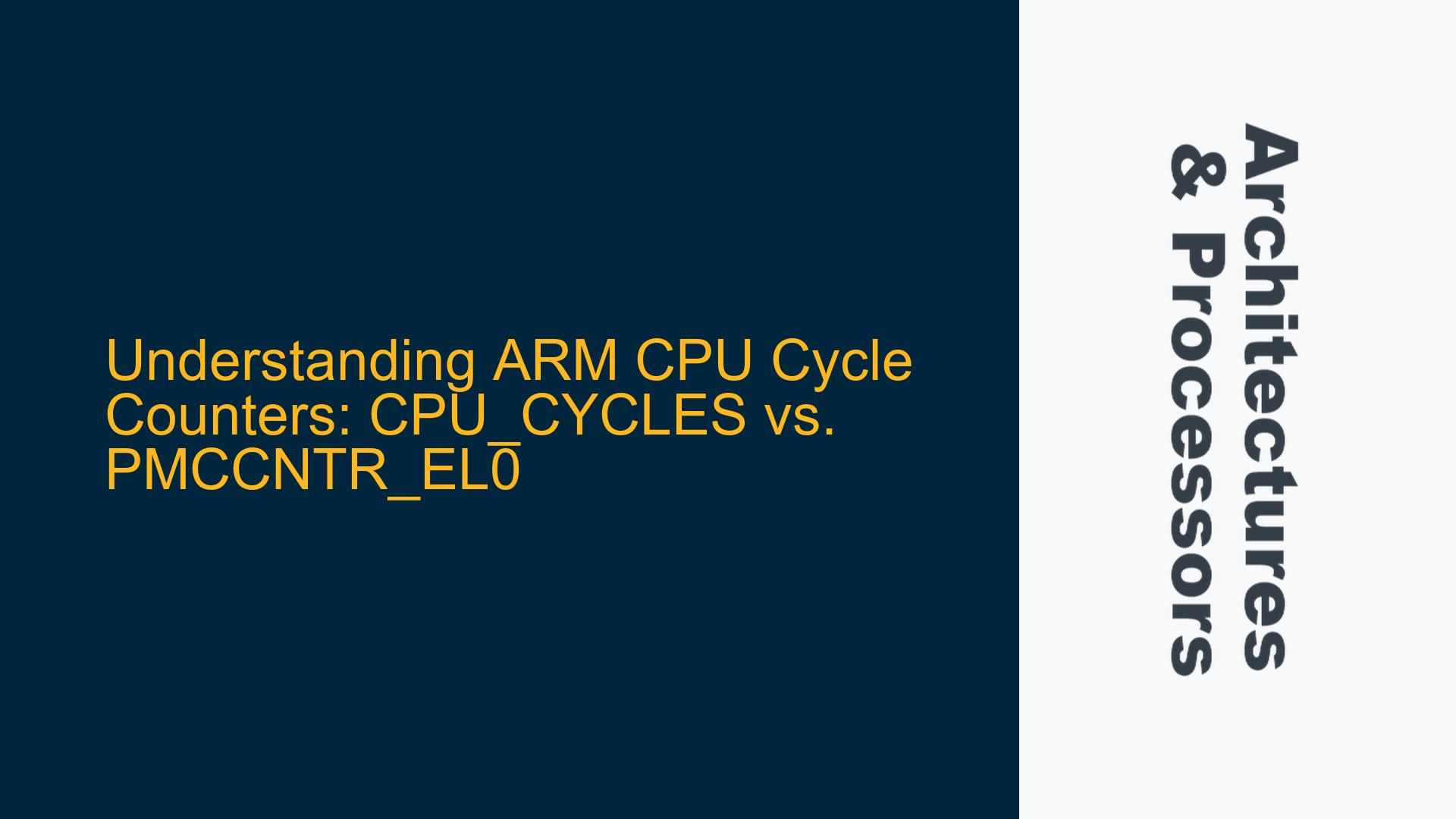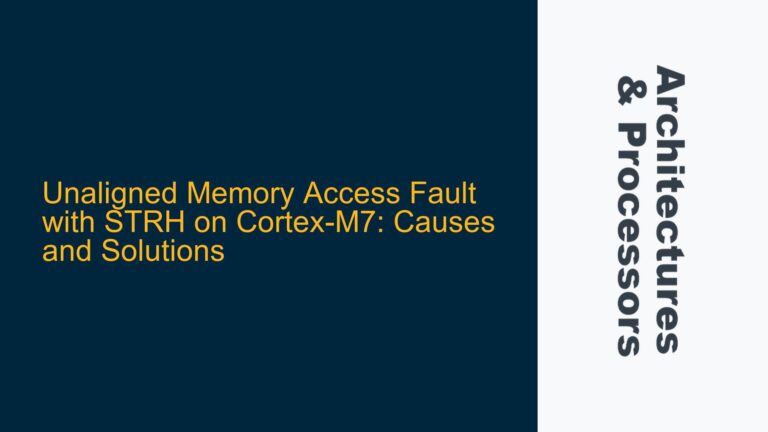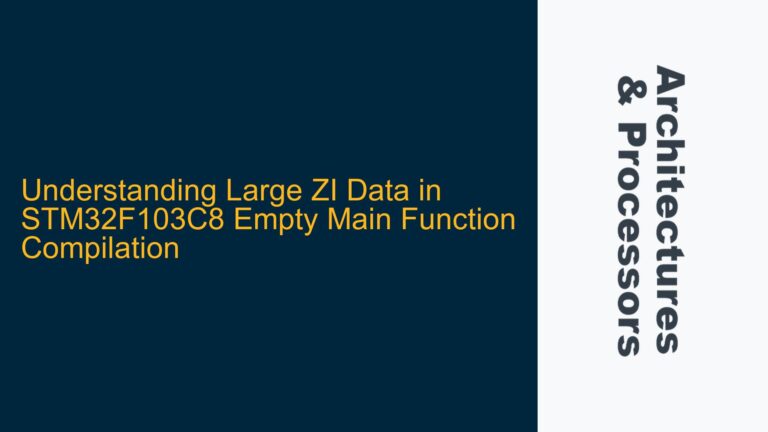ARM Cortex CPU Cycle Counting Mechanisms: CPU_CYCLES and PMCCNTR_EL0
The ARM architecture provides two distinct mechanisms for counting CPU cycles: the CPU_CYCLES Performance Monitoring Unit (PMU) event and the dedicated cycle counter register PMCCNTR_EL0. While both mechanisms aim to measure CPU cycles, they serve different purposes and operate under different constraints. The CPU_CYCLES event is part of the PMU event counters, which are programmable and can be configured to count various microarchitectural events. On the other hand, PMCCNTR_EL0 is a dedicated register specifically designed to count CPU cycles with minimal overhead and is accessible in privileged modes.
The CPU_CYCLES event is typically used in performance profiling and debugging scenarios where fine-grained control over event counting is required. It allows developers to count cycles in specific contexts, such as within a particular function or during the execution of a specific instruction sequence. However, the CPU_CYCLES event is subject to the limitations of the PMU, including the need to configure and enable the PMU, potential contention with other PMU events, and the overhead associated with reading the event counters.
In contrast, PMCCNTR_EL0 is a dedicated cycle counter that is always active and does not require explicit configuration or enablement. It provides a low-latency, high-resolution means of measuring CPU cycles, making it ideal for real-time performance monitoring and benchmarking. The PMCCNTR_EL0 register is part of the ARMv8-A architecture and is accessible in EL1 (kernel mode) and higher privilege levels. It is particularly useful in scenarios where the overhead of configuring and reading PMU event counters is prohibitive.
The coexistence of CPU_CYCLES and PMCCNTR_EL0 in the ARM architecture reflects the need for both flexibility and efficiency in cycle counting. While CPU_CYCLES offers programmability and integration with the PMU, PMCCNTR_EL0 provides a streamlined, dedicated solution for cycle counting. Understanding the differences between these two mechanisms is crucial for selecting the appropriate tool for a given use case.
Architectural Differences and Use Cases for CPU_CYCLES and PMCCNTR_EL0
The architectural differences between CPU_CYCLES and PMCCNTR_EL0 stem from their design goals and implementation details. CPU_CYCLES is implemented as a PMU event, which means it is part of a broader framework for performance monitoring. The PMU in ARM processors supports a wide range of events, including cache misses, branch mispredictions, and instruction retirements, in addition to CPU cycles. The PMU event counters are typically limited in number, and configuring them involves setting up event selection registers, enabling counters, and handling overflow conditions.
PMCCNTR_EL0, on the other hand, is a dedicated register that is always counting CPU cycles. It is part of the ARMv8-A Performance Monitors Extension and is designed to provide a high-resolution, low-overhead means of measuring CPU cycles. The PMCCNTR_EL0 register is incremented at the CPU clock frequency and can be accessed directly using the MRS instruction. Unlike the PMU event counters, PMCCNTR_EL0 does not require explicit configuration or enablement, making it simpler to use in many scenarios.
The use cases for CPU_CYCLES and PMCCNTR_EL0 differ based on their respective strengths and limitations. CPU_CYCLES is well-suited for detailed performance analysis, where the ability to count cycles in specific contexts or in conjunction with other PMU events is valuable. For example, a developer might use CPU_CYCLES to measure the cycle count of a specific function while simultaneously monitoring cache misses or branch mispredictions. This level of granularity is essential for identifying performance bottlenecks and optimizing code.
PMCCNTR_EL0, by contrast, is ideal for scenarios where low overhead and high resolution are critical. Real-time systems, for instance, often require precise timing measurements with minimal disruption to the system’s operation. PMCCNTR_EL0 provides a straightforward way to measure CPU cycles without the need for complex configuration or the risk of contention with other PMU events. Additionally, PMCCNTR_EL0 is often used in benchmarking and performance comparison studies, where consistent and accurate cycle counts are essential.
Another important consideration is the privilege level required to access these cycle counting mechanisms. CPU_CYCLES, as part of the PMU, typically requires privileged access to configure and read the event counters. PMCCNTR_EL0, while also accessible only in privileged modes, is simpler to use and does not require the same level of configuration. This makes PMCCNTR_EL0 more accessible for quick performance measurements in kernel code or hypervisor implementations.
Optimizing Cycle Counting: Best Practices for CPU_CYCLES and PMCCNTR_EL0
To effectively leverage CPU_CYCLES and PMCCNTR_EL0, developers must understand the best practices for using these mechanisms in different scenarios. For CPU_CYCLES, the key is to carefully configure the PMU to ensure accurate and meaningful cycle counts. This involves selecting the appropriate event (0x0011 for CPU_CYCLES), enabling the counter, and handling overflow conditions. Developers should also be aware of the potential impact of PMU configuration on system performance, as enabling multiple PMU events can introduce overhead.
When using CPU_CYCLES, it is important to consider the context in which the cycle count is being measured. For example, if the goal is to measure the cycle count of a specific function, the PMU should be configured to start counting at the beginning of the function and stop at the end. This can be achieved using inline assembly or compiler intrinsics to insert the necessary PMU control instructions. Additionally, developers should account for any overhead introduced by the PMU itself, as reading and resetting the counters can add cycles to the measurement.
For PMCCNTR_EL0, the primary consideration is ensuring that the register is accessible and that the cycle count is read accurately. Since PMCCNTR_EL0 is always counting, developers can simply read the register at the start and end of the measurement interval and compute the difference to obtain the cycle count. However, care must be taken to handle potential overflow, especially in long-running measurements. The PMCCNTR_EL0 register is 64 bits wide, which provides a large range for cycle counting, but overflow can still occur in extreme cases.
In real-time systems, where timing accuracy is critical, PMCCNTR_EL0 is often the preferred choice due to its low overhead and high resolution. Developers should ensure that the register is accessible in the context where the measurement is needed, which may involve modifying the system’s privilege level or using hypervisor features to expose PMCCNTR_EL0 to user-space applications. Additionally, developers should be aware of any potential side effects of accessing PMCCNTR_EL0, such as pipeline stalls or cache effects, which can impact the accuracy of the measurement.
In benchmarking and performance comparison studies, both CPU_CYCLES and PMCCNTR_EL0 can be used, but the choice depends on the specific requirements of the study. CPU_CYCLES offers the flexibility to measure cycles in conjunction with other PMU events, providing a more comprehensive view of performance. PMCCNTR_EL0, on the other hand, provides a simpler and more consistent means of measuring cycles, which is often sufficient for high-level performance comparisons.
Ultimately, the choice between CPU_CYCLES and PMCCNTR_EL0 depends on the specific requirements of the application and the trade-offs between flexibility, overhead, and ease of use. By understanding the strengths and limitations of each mechanism, developers can make informed decisions and optimize their use of ARM’s cycle counting capabilities.






